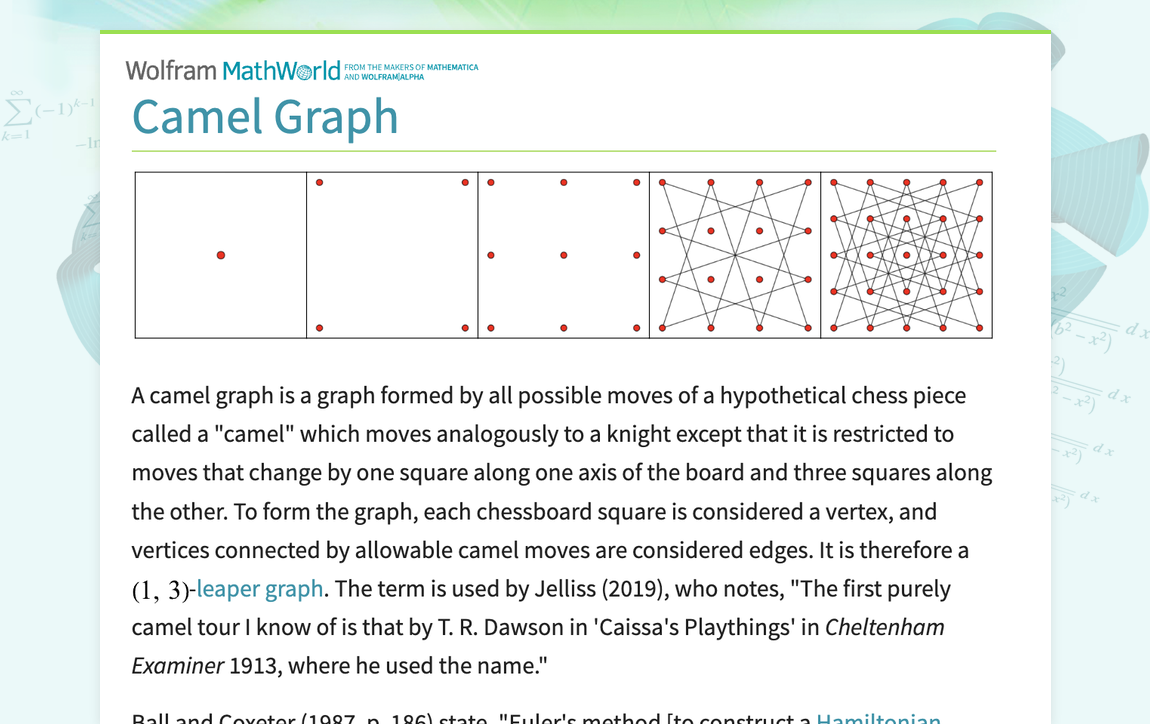
mathworld.wolfram.com/CamelGraph.html
Preview meta tags from the mathworld.wolfram.com website.
Linked Hostnames
7- 42 links tomathworld.wolfram.com
- 5 links towww.wolfram.com
- 4 links towww.wolframalpha.com
- 2 links towww.amazon.com
- 1 link toreference.wolfram.com
- 1 link towolframalpha.com
- 1 link towww.mayhematics.com
Thumbnail

Search Engine Appearance
Camel Graph -- from Wolfram MathWorld
A camel graph is a graph formed by all possible moves of a hypothetical chess piece called a "camel" which moves analogously to a knight except that it is restricted to moves that change by one square along one axis of the board and three squares along the other. To form the graph, each chessboard square is considered a vertex, and vertices connected by allowable camel moves are considered edges. It is therefore a (1,3)-leaper graph, as well as the Euclidean distance-sqrt(10)...
Bing
Camel Graph -- from Wolfram MathWorld
A camel graph is a graph formed by all possible moves of a hypothetical chess piece called a "camel" which moves analogously to a knight except that it is restricted to moves that change by one square along one axis of the board and three squares along the other. To form the graph, each chessboard square is considered a vertex, and vertices connected by allowable camel moves are considered edges. It is therefore a (1,3)-leaper graph, as well as the Euclidean distance-sqrt(10)...
DuckDuckGo
Camel Graph -- from Wolfram MathWorld
A camel graph is a graph formed by all possible moves of a hypothetical chess piece called a "camel" which moves analogously to a knight except that it is restricted to moves that change by one square along one axis of the board and three squares along the other. To form the graph, each chessboard square is considered a vertex, and vertices connected by allowable camel moves are considered edges. It is therefore a (1,3)-leaper graph, as well as the Euclidean distance-sqrt(10)...
General Meta Tags
30- titleCamel Graph -- from Wolfram MathWorld
- DC.TitleCamel Graph
- DC.CreatorWeisstein, Eric W.
- DC.DescriptionA camel graph is a graph formed by all possible moves of a hypothetical chess piece called a "camel" which moves analogously to a knight except that it is restricted to moves that change by one square along one axis of the board and three squares along the other. To form the graph, each chessboard square is considered a vertex, and vertices connected by allowable camel moves are considered edges. It is therefore a (1,3)-leaper graph, as well as the Euclidean distance-sqrt(10)...
- descriptionA camel graph is a graph formed by all possible moves of a hypothetical chess piece called a "camel" which moves analogously to a knight except that it is restricted to moves that change by one square along one axis of the board and three squares along the other. To form the graph, each chessboard square is considered a vertex, and vertices connected by allowable camel moves are considered edges. It is therefore a (1,3)-leaper graph, as well as the Euclidean distance-sqrt(10)...
Open Graph Meta Tags
5- og:imagehttps://mathworld.wolfram.com/images/socialmedia/share/ogimage_CamelGraph.png
- og:urlhttps://mathworld.wolfram.com/CamelGraph.html
- og:typewebsite
- og:titleCamel Graph -- from Wolfram MathWorld
- og:descriptionA camel graph is a graph formed by all possible moves of a hypothetical chess piece called a "camel" which moves analogously to a knight except that it is restricted to moves that change by one square along one axis of the board and three squares along the other. To form the graph, each chessboard square is considered a vertex, and vertices connected by allowable camel moves are considered edges. It is therefore a (1,3)-leaper graph, as well as the Euclidean distance-sqrt(10)...
Twitter Meta Tags
5- twitter:cardsummary_large_image
- twitter:site@WolframResearch
- twitter:titleCamel Graph -- from Wolfram MathWorld
- twitter:descriptionA camel graph is a graph formed by all possible moves of a hypothetical chess piece called a "camel" which moves analogously to a knight except that it is restricted to moves that change by one square along one axis of the board and three squares along the other. To form the graph, each chessboard square is considered a vertex, and vertices connected by allowable camel moves are considered edges. It is therefore a (1,3)-leaper graph, as well as the Euclidean distance-sqrt(10)...
- twitter:image:srchttps://mathworld.wolfram.com/images/socialmedia/share/ogimage_CamelGraph.png
Link Tags
4- canonicalhttps://mathworld.wolfram.com/CamelGraph.html
- preload//www.wolframcdn.com/fonts/source-sans-pro/1.0/global.css
- stylesheet/css/styles.css
- stylesheet/common/js/c2c/1.0/WolframC2CGui.css.en
Links
56- http://reference.wolfram.com/language/ref/GraphData.html
- http://www.amazon.com/exec/obidos/ASIN/0486253570/ref=nosim/ericstreasuretro
- http://www.mayhematics.com/p/KTN10_Leapers.pdf
- http://www.wolfram.com/language
- http://www.wolframalpha.com/input/?i=Julia+set+-0.40%2B0.65i